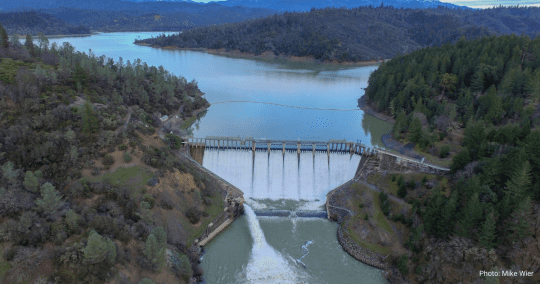Update: Potter Valley Project on the Eel River

A statement prepared by Redgie Collins (CalTrout’s Legal and Policy Director) and Curtis Knight (CalTrout’s Executive Director)
A New Path Forward for Potter Valley Project
Restoring Eel and Russian Rivers for the benefit of people and wildlife.
In response to a recent decision from federal regulators, California Trout sees a clear path towards the removal of Scott Dam and the historic restoration of the upper Eel River watershed in Northern California. The Federal Energy Regulatory Commission (FERC) rejected a recent request from the Two-Basin Partnership asking for additional time to complete critical studies and determine the appropriate strategy in developing a system for ongoing water transfers and fisheries restoration on the Eel and Russian Rivers. CalTrout is one of five entities that compose the Partnership.
Background
Scott Dam makes up one part of a multiplex of outdated 100+ year old facilities on the Eel River, which is known collectively as the Potter Valley Project. The Project is owned and licensed by PG&E. Rather than pursue a new license for the Project, PG&E decided in 2019 to instead abandon its license.
Because federal law prohibits dam owners from simply abandoning such facilities, PG&E’s best long-term solution is to negotiate a settlement agreement with CalTrout and other interested stakeholders. Any settlement will ensure that PG&E covers the lion’s share of decommissioning costs while coordinating with stakeholders to achieve a Two-Basin solution.
“The decision by FERC essentially means that PG&E will surrender the project and enter a FERC-driven process to decommission all the facilities, including removing Scott Dam,” explained CalTrout Executive Director Curtis Knight. “The Two-Basin Partnership is currently the only entity that can take over the license, and our bid came up short due to PG&E’s unwillingness to be a meaningful partner and FERC’s recent rejection of our abeyance request.”
CalTrout to Take Action
Given FERC’s decision, CalTrout will now shift its focus to working with PG&E and stakeholders to negotiate the company’s plans to remove Scott Dam, effectively opening up the 288 linear river miles of spawning and rearing habitat for salmon and steelhead that’s located up-river of the facilities. While this shift in approach indicates the end of the licensing process, CalTrout remains committed, along with its Two-Basin Solution partners, to securing a solution that meets the needs of people and wildlife in both the Russian and Eel River Basins.
CalTrout and the Partners filed a letter with FERC today on November 22nd, which reiterates the path towards surrender.
Restoring access to this habitat is key to the revival of dwindling native fish populations. Studies have shown that the Eel River is one of the best places in California to support fish recovery because it is one of few rivers where sustainable wild fish abundance is still possible.
PG&E’s Responsibilities
Protecting salmon and steelhead is not just a nice idea. It’s something that FERC is legally obligated to do as it considers what’s next for the Potter Valley Project during a surrender proceeding. With this obligation in mind, the Partnership had been moving through the FERC process while simultaneously ironing out details of a plan that could meet the needs of both farmers and fish.
The surrender process means that PG&E will have to decommission the Project. The only way for PG&E to limit its long-term liability and cost to ratepayers is to remove all facilities. CalTrout will continue to advocate for the removal of both Scott Dam and Cape Horn Dam, but with updated infrastructure; the goal being to continue the ongoing water diversions into the Russian River system yet done in a manner that includes more protection for Eel River fish than what currently exists. Early studies show that diversions during the winter months and on-farm efficiencies can be leveraged to ensure sufficient enough water is diverted to support essential water needs, even if both dams are removed.
The Potter Valley Project is a major liability for PG&E. CalTrout estimates that the company loses $7-10 million a year on the Project, and that is prior to factoring in their recent report regarding the inoperable powerhouse and expensive $10-15 million transformer blow-out. Without power generation, the money lost by PG&E on operation of the Project will certainly climb. “PG&E has not fulfilled its end of obligations for the Eel River, and if PG&E wants to meet its obligations to its rate payers and the California Public Utilities Commission (CPUC), the company should swiftly enter into settlement negotiations to remove Scott and Cape Horn dams,” says Redgie Collins, CalTrout’s Legal and Policy Director.
“While the path may have changed, the recovery of the Eel River has never been more certain,” concluded Knight. “CalTrout will continue to advocate, along with our partners, for the goals of Two-Basin Solution.”
Stay tuned for the release of three potential fish passage solutions at Cape Horn Dam and for an updated sediment management and dam removal strategy for Scott Dam.
The post Update: Potter Valley Project on the Eel River appeared first on California Trout.


